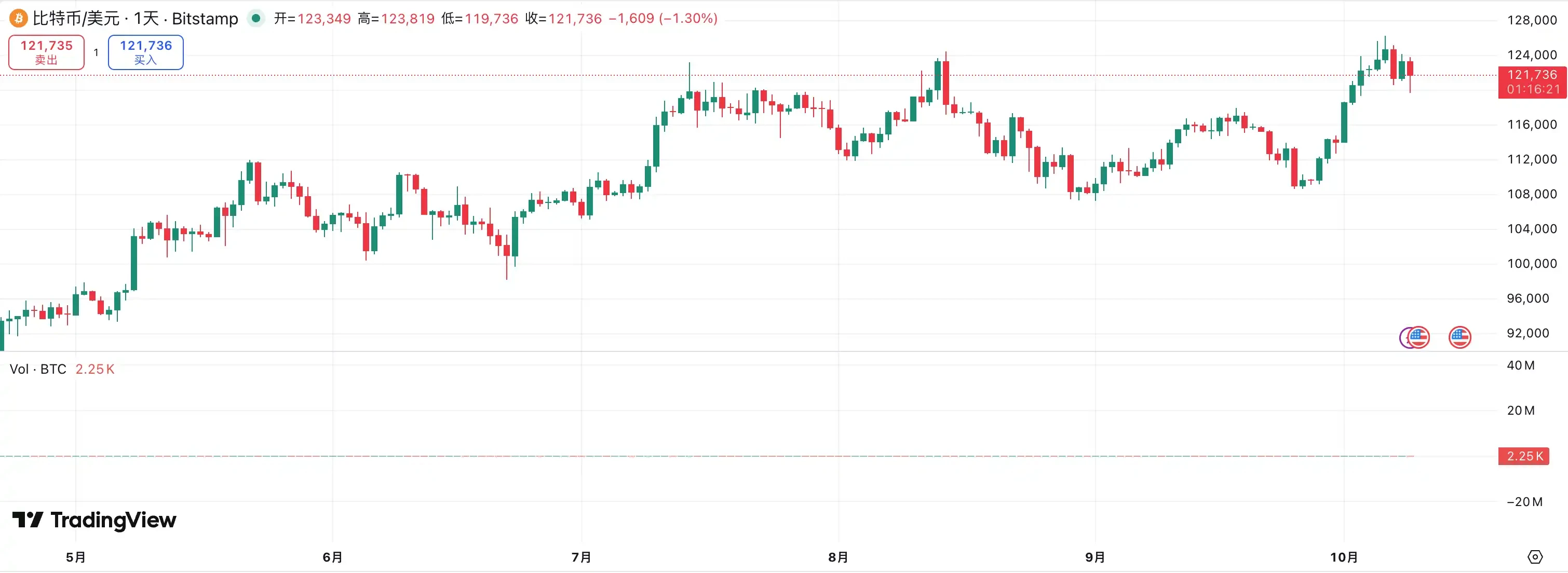Market Analysis: Bitcoin's October Quest for a New High
- 核心观点:比特币创新高,市场进入狂热周期。
- 关键要素:
- BTC突破125,000美元历史高点。
- 美联储降息预期高达94.1%。
- 流动性驱动风险资产上涨。
- 市场影响:推动加密资产普涨,吸引资金流入。
- 时效性标注:短期影响
On October 6th, Bitcoin surged past $125,000, setting a new all-time high and signaling the official entry of a new market frenzy. Along with BTC's surge, major altcoins like Aster and BNB surged, and on-chain liquidity on the Bitcoin Scale (BSC) saw a significant return, returning market sentiment to its peak of the year. A brief dip triggered by the US government shutdown has now been completely overwhelmed by a "FOMO" (Fear of Momentum) rally.
From a macro perspective, expectations of easing are providing solid support for risky assets. According to CME FedWatch data, the probability of an interest rate cut in October and December is currently as high as 94.1% and 84%, respectively. The market generally believes that the Federal Reserve has entered the "pre-communication phase" before a policy turning point, with fiscal and liquidity easing becoming the main themes. With the weakening US labor market, easing debt ceiling pressure, and continued monetary easing by the Treasury, real US dollar interest rates are showing signs of decline, and funds are accelerating their outflow from the money market and flowing back into stocks and crypto assets. This round of price increases is both an early response to expectations of rate cuts and the resumption of liquidity, and a typical "capital-driven bull market."

Next, BlockBeats has compiled traders’ views on the upcoming market conditions to provide some direction for your trading this week.
@CryptoHayes
In his latest article, "Long Live the King," Arthur Hayes systematically expounds on the evolutionary logic of Bitcoin's price cycles, arguing that "the four-year halving cycle is dead, and the liquidity cycle is here to stay." He points out that Bitcoin's three historical bull-bear cycles were ultimately driven by the expansion and contraction of US dollar and RMB liquidity, rather than changes in block rewards. From 2009 to 2013, the Federal Reserve's initial quantitative easing (QE) and China's credit stimulus jointly fueled Bitcoin's birth and initial bull market. From 2013 to 2017, China's credit surge fueled the ICO boom, which ultimately burst when monetary tightening brought the bubble to a halt. From 2017 to 2021, the "flooding" policies of the Trump and Biden eras created the largest liquidity expansion in history, driving Bitcoin to new all-time highs.

As we head into 2025, Hayes believes the world is returning to an easing narrative. The US Treasury is releasing trillions of dollars in liquidity through the issuance of short-term Treasury bills, forcing the Federal Reserve to resume interest rate cuts amidst soaring inflation. China, facing a real estate recession and deflationary pressures, is once again easing credit and stimulating domestic demand. With both economies experiencing monetary easing, capital is bound to flow back into risky asset markets.
@Jackyi_ld
Liquid Capital founder Yi Lihua posted a message stating that a major bargain hunting opportunity is coming, urging patience and blocking out the noise. Sell when the market is buzzing and buy when the market is quiet. Seize the opportunity and go long. The three most cyclical assets in the cryptocurrency market: public chains (BTC, ETH, etc.), exchanges (BNB, Aster, etc.), and stablecoins (WLFI, Tether shares, etc.).
@Phyrex_Ni
This round of risk market gains is essentially a product of the market "preempting" expectations of Federal Reserve easing. The US government shutdown and Trump's layoffs have investors betting on an October rate cut, leading to gains in US stocks, cryptocurrencies, and gold. However, this "happy ending" rally is largely driven by sentiment. In reality, the Federal Reserve remains in a high-interest rate cycle, with rising inflation stickiness, slowing wage growth, and declining real purchasing power. Weak labor market data, however, exposes structural risks in the economy.
At the macro level, the US fiscal deficit continues to widen, US Treasury yields and the US dollar index have both risen, and gold prices have also strengthened. This reflects that global capital is seeking the safe haven of the US dollar while also raising doubts about the US's long-term solvency. In the short term, the data vacuum caused by the shutdown will continue to maintain optimism, and funds may continue to flow into risky assets, but this is just a "false boom without data." If inflation data returns to high levels, the Federal Reserve will be forced to tighten policy, and the market may face a sharp turn.
@Corsica 267
The root cause of the current US economic problems lies in the structural contradiction between weak demand and high debt. Long-term low interest rates and rising productivity have weakened investment returns and widened the wealth gap, while an aging population and slowing consumption have further suppressed growth momentum. Faced with this "high debt + low growth" dilemma, Treasury Secretary Bensont is employing a "financial repression" strategy to resolve the debt burden: capping interest rates, tolerating inflation, and attracting passive buyers to keep nominal economic growth above financing costs, thereby "wearing away" the debt burden.
This has led to a market mismatch where nominal rate cuts lag behind real easing. Even if the Fed cuts rates, if inflation expectations fall faster, real interest rates will rise, creating a passive tightening. The current division of labor between the Federal Reserve and the Treasury is: the former stabilizes livelihoods, while the latter stabilizes government bonds. While fiscal stimulus supports asset prices, the Fed faces a difficult trade-off between employment and inflation.
At the asset level, tech stocks and gold are rising in tandem. Tech stocks rely on declining discount rates and the illusion of long-term growth, forming a "productive bubble," while gold benefits from a "double premium" of lower real interest rates and rising institutional uncertainty. The simultaneous rise of these two stocks essentially reflects a consensus on pricing in an era of financial repression: expected real returns on capital are declining, while risk aversion and growth have become the only certainties.
Future trends depend on:
If inflation is controlled and fiscal repression continues, risky assets and gold will remain supported;
If inflation re-emerges and real interest rates rise, the bubble will be forced to deflate.
In short, this is an era where growth is exchanged for financial repression and assets are supported by institutional premiums - prosperity and risk coexist, and the high point of valuation is also the low point of institutional trust.
@JPMorgan
In an October 1 report, JPMorgan analysts pointed out that Bitcoin is expected to continue to rise. The reason is that the so-called "currency devaluation trade" has revived - retail and institutional investors tend to hedge their risks by allocating gold and Bitcoin amid concerns about geopolitical uncertainty, high global debt levels and the weakening dominance of the US dollar.
More broadly, a number of recent developments in the crypto industry indicate that it is steadily integrating into the mainstream financial system, including the launch of multiple new crypto ETFs and the rise of "crypto treasury stocks", indicating that the capital market's acceptance and participation in this field continues to increase.



